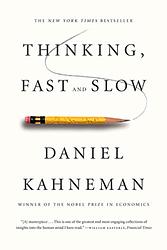Thinking, Fast and Slow by Daniel Kahneman
The book delves into the two systems that drive the way we think—System 1, which is fast and intuitive, and System 2, which is slow and deliberate. The author, a Nobel laureate, explores how these systems shape our judgments and decision-making. He presents several groundbreaking experiments that have shaped our understanding of human thought, revealing where we can trust our intuitions and how we can tap into the benefits of slow thinking. The book also discusses how our cognitive biases often lead to errors in judgment and affect our decision-making processes.
The 2511th greatest book of all time
- Published
- 2011
- Nationality
- Israeli
- Type
- Nonfiction
- Pages
- 499
- Words
- 198,000
- Original Language
- English
If you're interested in seeing the ranking details on this book go here
This book is on the following lists:
- 76th on The 100 best books of the 21st century (The Guardian)
- 100 Best Books of the Decade so Far (2010-2015) (Oyster Books)
- The 10 Best Books Through Time (New York Times)
- The Ultimate Book Bucket List: The 75 Best Books Of All Time (Refinery29)
- The Books You've Always Meant to Read (Waterstones)
- Bill Gate's Book Recommendations (Bill Gates)

